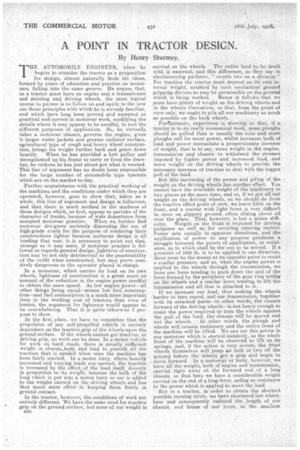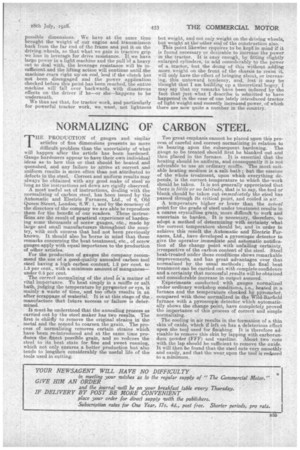A POINT IN TRACTOR DESIGN.
Page 12

Page 13

If you've noticed an error in this article please click here to report it so we can fix it.
By Henry Sturrney.
THE AUTOMOBILE ENGINEER, when he begins to consider the tractor as a proposition for design, almost naturally finds his ideas, Formed by years of education and practice on motoroars, falling into the same groove. He argues that, as a tractor must have an engine and a transmission and steering• and driving wheels, the niost logical course to pursue is to follow on and apply to the new use those principles with which he is already familiar, and which have long been proved and accepted as practical and correct in motorcar work, modifying the details where it may appear to be needful, to suit the different purposes of application. So, he virtually takes a motorcar chassis, governs the engine, gives it larger water jackets and greater radiator surface, agricultural type of rough and heavy wheel construction, brings his weight further back and gears down heavily. When he has provided a belt pulley and strengthened up his frame to carry or form the drawbar, he reckons he has just about got what is wanted. This line of argument has no doubt been responsible for the large number Of automobile type tractors which are on the market to-day.
Further acquaintance with the practical working of the machines and the conditions under which they are operated, however, goes to show that, taken as a whole, this line of argument and design is fallacious, and that there is much method in the madness of those designs which, at first, appear to partake of the character of freaks, because of wide departures from accepted motorcar practice. When we further find motorcar designers seriously discussing the use of high-grade steels for the purpose of rendering their constructions lighter because motorcar design is all tending that way, it is necessary to paint out that, strange as it may seem, if motorcar practice is followed as regards general design, lightness of construction may be not only detrimental to the practicability of the outfit when constructed, but may prove positively dangerous to the operator placed in charge.
In a Motorcar, which carries its load on its own wheels, lightness of construction is a great asset on .account of the reduction in the engine power needful to obtain the same speed. As low engine power—all other things being equal—means low fuel consumption—and fuel consumption is a much more important item in the working cost of tractors than even of lorries, the argument for lightness, would appear to be overwhelming. That it is quite otherwise I propose to show.
In the first place, we have to remember that the propulsion of any self-propelled vehicle is entirely dependent on the tractive grip of the wheels upon the ground surface. If the wheels cannot get traction, or driving grip, no work can be done. In a motor vehicle for work on hard roads, there is usually sufficient weight in chassisabody and load to provide all the traction that is needed when once the machine has been fairly started. In a motor lorry, where heavily increased and varying loads are carried, the tractiOn is increased by the effect of the load itself, directly in proportion to its weiglit, because the bulk of the loael vihich is put into a motor lorry or car is added to the weight carried on the driving wheels and has that much more effect in keeping them firmly in ground contact.
In the tractor, however, the conditions of work ana entirely different. We have the same need for tractive grip on the ground surface, but none of our weight is 3334 carried On the wheels. The entire load to be. dealt with is external, and this difference, as they say in. electioneering parlance, counts two on a division." For traction the tractor Must depend on its own internal weight, assisted by such mechanical ground gripping devices as maybe permissible on the ground which is being worked. Hence it follows that we must have plenty of weight on the driving wheels and in the wheels themselves, so that, from the point of view only, we ought to pile all our machinery as much as possible on the back wheels.
Furthermore, experience is showing us that, if a tractor is to do really economical work, more ploughs should be pulled than is usually the cdse and more ploughs call for more power, whilst increases both of load and power, necessitate a proportionate increase of weight, that is to sayamore weight in the engine, transmission and chassis to withstand the stresses imposed by higher ,power and increased load, and more weight on , the driving wheels to provide the necessary increase of traction to deal with the bigger pull of the load.
But this increasing of the power and piling of the weight on the driving *heels has another effect. You cannot have the available weight of the machinery in two places at the same time, and so, if we put all our weight .on the driving wheels, as we should do from the tractive effect point of view, we leave little on the front, and a tractor with light front is very difficult to steer on slipperY ground, often sliding about all over the place. That, however; is but a minor difficulty. Weight on the front is required for driving purposes as well as for securing steering control. Power acts equally inopposite directions, and the application of power to any purpose produces a struggle between the points of ,application, or resistance, as to which shall be the one to be moved. If a pressure of 1000 lb. is to be applied in one direction, there must be the means at an opposite point to resist
similar pressure, and-so, when the engine power is -applied to the wheels through the transmission, we have One force tending to push dawn the end of the lever formed by the periphery of the gear ring acting on the wheels and a similar orce tending to lift the transmission and all that is attached to it.
If we increase our load, thus making the wheels harder to turn round, and oar transmission, together with its attached parts—in other words, the chassis forward of the driving wheels--is not heavy enough to resist the power required to turn the wheels against the pull of the load, the chassis will be moved and not the wheels. In other words, the plough and wheels will remain stationary and the entire front of. the machine will be lifted. We can see this action in any motorcar which is started suddenly, as the whole front of the machine will be observed to lift on its springs, and, if the action is very severe, the &salt wheels themSelves will jump an inch or two off the ground before the wheels get a grip and begin to move forward, in a motorcar or lorry, however, we have all the weight, both of engine and transmission, carried right away at the forward end of a long chassis, so that here we have a considerable weight carried on the end of a long lever, acting as resistance to the power which is applied to move the load. But in a tractor, in order to obtain the shortest possible turning circle, w,e have shortened ()ur wheelbase and consequently reducedthe length of our chassis, and hence of our lever, to the smallest
possible dimensions. We have at the same time brought the weight of our engine and transmission back from the far end of the frame and put it on the driving wheels, so that what we gain in tractive grip we lose in leverage for drive resistance. If, we have large power in a light machine and the pull Of a heavy cut to dead with, the leverage resistance will he insufficient and the lifting action will continue until the machine rears right up .on end, 'and if the clutch has not been disengaged and the power application checked before this point has been reached, the entire machine will fall over backwards with disastrous effects on the driver if he—or she—happens to be underneath.
We thus see that, for tractor work, and particularly for powerful tractor work, we want, not lightness but weight, and not only weight on the driving wheels, but weight at the ether end of the construction also.
This point likewise requires to be kept in mind if' it is found necessary or desirable to increase the power in the tractor. It is easy enough, by fitting slightly enlarged cylinders, to add considerably to the power of a tractor, but the doing of this without adding more weight on the front of the chassis to resist it, will only have the effect of bringing about, or increasing, this untoward tendency, and, lest it may be thought that I am building up a theoretical bogey, I may say that my remarks have been induced by the fact thatjust what 1 describe is admitted to have happened in the ease of one lately introduced tractor of light weight and recently increased power, of which there are now quite a number in the country.






















